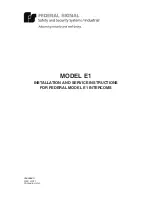
Page
3
of
4
Initial Adjustments:
There are both
Input and Output Controls with associated Indicators
When the Indicators are green the associated control is enabled
The Audio may be 'Keyed' depending on the Configuration and system setup
Only attempt adjustments if the associated indicator is lighted green
!
The CI-BUSS uses a standard audio level of ~0dBm RMS
The Digital Rotary Switch (3dB/Step) is used to set Microphone Gain
The nominal Microphone gain is ~6dB, or less, into limiting
Microphone Gain is always setup first
Initially, the Output level controls should be set to minimum (No Output)
Limiter Setup with a Microphone:
Always do first
Provide a normal input to the Microphone, or Line input
Insure the Microphone is Keyed, the indicator is Green
Advance the “Microphone Gain”, from “0” until the Talk Level indicator just flashes red
Advance the “Microphone Gain” no more than two clicks (6dB into limiting)
Monitor/Communications and Speaker setup:
Assure there is an audio input
With normal audio input levels, with Inputs and outputs keyed (Output Indicator Green)
Set the Speaker Listening Level
See the PA-BUSS Section for Monitor/Communications Output Adjustments
Notch Filter Setup:
Do after initial setup
The factory settings are: LO, fully CCW, HI, Fully CW; the Notch Filters are essentially disabled
Notch Filters can greatly reduce feedback; however they cannot make up for poor acoustic isolation
There are two distinct primary resonance modes in most installations. One is room resonance; one mode is
most prevalent, such as floor to ceiling resonance. This frequency is usually on the order of a few hundred
cycles. The second mode is the distance of the microphone from a near object. This frequency is much higher
near 1000Hz. The MSI-22 incorporates two filters in tandem, one a low Band Filter 250Hz to 1000Hz, and the
other a High band Filter 750Hz to 3000Hz
Adjust the Notch Filters one at a time. Increase the Microphone Gain Control until feedback occurs.
Make a rough determination of the frequency (or measure the frequency with a counter).
If the feedback is below ~800Hz, adjust the ‘Lo Notch’ until feedback ceases. If the feedback is above
~800Hz, adjust the ‘Hi Notch’ until feedback ceases. (This is a 20-turn pot so it is best to start from one
extreme, and slowly turn the pot in the other direction
Increase the Microphone Gain Control until feedback occurs again, if it is at the same frequency; try finely
adjusting the same filter to see if the feedback can be eliminated. If the frequency is different, and in the other
range not already tuned, repeat the steps above
If only one Notch Filter is required, the other filter should be set at the extreme of its range.
Fully CCW (lowest frequency) for the LO filter, and fully CW ( highest frequency) for the HI filter.
After the Notch Filters are adjusted, redo the initial adjustment above
Note:
Before making any adjustments assure there are audio Inputs and Outputs
All the associated indicators must be lighted green






















